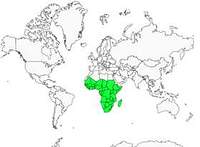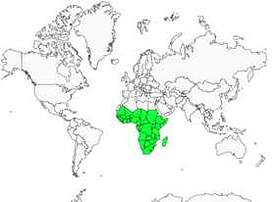African Pygmy Goose
Nettapus auritus - Anserelle naine
Identification
The African Pygmy Goose is a small Anatidae (30-35 cm, weighing under 300 g), easily recognizable by its white face, its reddish underside and its dark green back.
The adult male in its nuptial plumage is especially distinguished by its entirely pure white face, its vivid orange bill with a black nail, and at the back of its head and neck, two black-fringed oval green patches.
In the female, the face and neck are dingy white, sometimes spotted with black. The forehead, headcap and nape are dark brownish-black. There is a dark line around the dark eye, and a blackish post-ocular band. The ear is adorned with a dark spot. The bill is less vivid orange than that of the male and has a dulled keel. The green of its back is usually more dull, less shiny, than that of the male.
When visible, the belly is white in both sexes. In flight, wings and tail are black. The wing shows a diagonal white bar which starts in the wrist area, passes through the coverts and broadens as it crosses the secondary remiges. The tertiaries and scapulars are shining dark green.
The young resemble the female, but are generally more beige-coloured. Young males acquire the orange bill and the green patch at the back of the head by the age of 6 months.
Subspecific information monotypic species
Foreign names
- Anserelle naine,
- Gansito africano,
- ganso-pigmeu-africano,
- Schmuckzwergente,
- afrikai törpelúd,
- Afrikaanse Dwergeend,
- Oca pigmea africana,
- afrikansk dvärgand,
- Praktdvergand,
- kačôčka čiapočkatá,
- kachnička pestrá,
- Afrikansk Dværgand,
- afrikankääpiösorsa,
- Dwerggans,
- oca pigmea africana,
- kaczuszka afrykańska,
- Африканский блестящий чирок,
- アフリカマメガン,
- 厚嘴棉凫,
- 厚嘴棉鴨,
Voice song and call
Habitat
Behaviour character trait
The African Pygmy Goose is a sedentary bird. However, it can make localized movements depending on the water level and the availability of food. It is very dependent on water and rarely ever comes ashore. It perches on submerged branches or trunks, or very close to the water. It usually lives in pairs or small family groups. Bigger gatherings are rare.
Flight
Dietfeeding habits
Reproduction nesting
The African Pygmy Goose is monogamous and couples form for a long duration. The start of breeding season is variable due to its vast geographical spread, but usually coincides with the rainy season.
The couple selects the nest site together, often a cavity in a tree (old woodpecker or barbican nest), less often on banks or in a termite mound. The choice of site is guided by its proximity to water. The couple lines the nest with twigs, leaves, and down. The female lays 8-12 eggs which she incubates alone for 3-4 weeks. The hatchlings emerge simultaneously. They are mostly fed by the female. The male defends the territory. The chicks take flight around 40 days old.Geographic range
Threats - protection
IUCN conservation status
concern
in the Wild
threatened
evaluated
The African Pygmy Goose is considered of minor concern by the IUCN due to its very wide distribution area. However its density is low and the bird is generally uncommon. Its global population, estimated at around 200,000 individuals, is tending to decrease.
Sources of information
- IOC World Bird List (v15.1), Gill, F and D Donsker (Eds). 2025-12-07.
- Roberts Bird Guide, Hugh Chittenden
- Vol. 1 - Handbook of the Birds of the World, Josep del Hoyo-Andrew Elliot-Jordi Sargatal
- Birds of Africa South of the Sahara, Ian Sinclair and Peter Ryan
- Birds of the World, The Cornell Lab of Ornithology
Other sources of interest
 Specification sheet created on
30/07/2023 by Dietmar Petrausch
Specification sheet created on
30/07/2023 by Dietmar PetrauschTranslation by AI Oiseaux.net
© 1996-2025 Oiseaux.net
- Accipitriformes
- Aegotheliformes
- Anseriformes
- Apodiformes
- Apterygiformes
- Bucerotiformes
- Caprimulgiformes
- Cariamiformes
- Casuariiformes
- Charadriiformes
- Ciconiiformes
- Coliiformes
- Columbiformes
- Coraciiformes
- Cuculiformes
- Eurypygiformes
- Falconiformes
- Galliformes
- Gaviiformes
- Gruiformes
- Leptosomiformes
- Mesitornithiformes
- Musophagiformes
- Nyctibiiformes
- Opisthocomiformes
- Otidiformes
- Passeriformes
- Pelecaniformes
- Phaethontiformes
- Phoenicopteriformes
- Piciformes
- Podargiformes
- Podicipediformes
- Procellariiformes
- Psittaciformes
- Pterocliformes
- Rheiformes
- Sphenisciformes
- Steatornithiformes
- Strigiformes
- Struthioniformes
- Suliformes
- Tinamiformes
- Trogoniformes






























